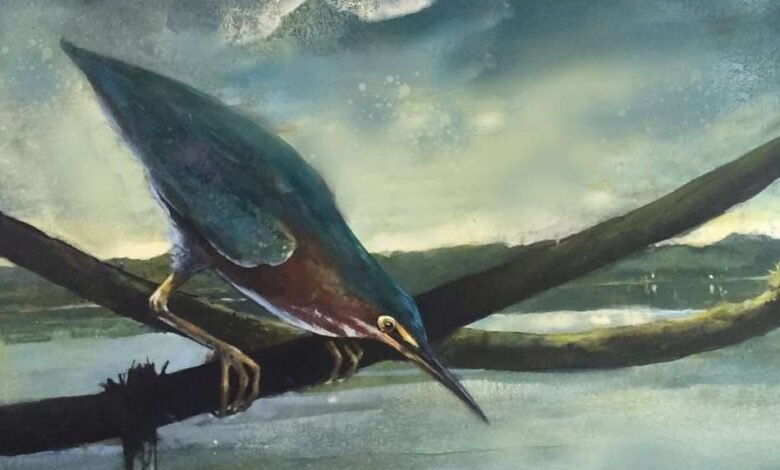Avian Tool Use: Not So Bird-Brained


 On an otherwise unremarkable day in 2023, Jason Love and his colleagues were gathering in a parking lot when they saw something that, as far as we know, no one had ever seen before. Love, the associate director of the Highlands Biological Station in North Carolina, and his colleagues were at a trailhead in the Great Smoky Mountains in Tennessee when he spotted a male northern cardinal attacking its reflection in a nearby car’s side mirror.
On an otherwise unremarkable day in 2023, Jason Love and his colleagues were gathering in a parking lot when they saw something that, as far as we know, no one had ever seen before. Love, the associate director of the Highlands Biological Station in North Carolina, and his colleagues were at a trailhead in the Great Smoky Mountains in Tennessee when he spotted a male northern cardinal attacking its reflection in a nearby car’s side mirror.
Male cardinals are known to engage in this mirror-attacking behavior, thinking their reflection is an aggressive rival that needs to be driven off. As the group watched the cardinal fight its imagined opponent, it did something unusual: it flew down to the ground, grabbed a piece of gravel, flew back up, and slammed it into the mirror.
The one-sided fight continued for several minutes. The bird appeared to be using the rock as a weapon – a behavior never before documented in northern cardinals.
When Love’s team published this observation in The Wilson Journal of Ornithology, they added cardinals to the ever-growing canon of birds that are known to use tools. The idea that a wide variety of birds can use tools is a relatively new one; in Jane Goodall’s 1971 global review of animal tool use, “Tool-Using in Primates and Other Vertebrates,” she only cited a handful of bird species as being capable of tool use. Now, a little more than 50 years later, dozens of bird species are known to use tools.
Perhaps the most adept tool-users among birds are corvids: jays, crows, ravens, and their relatives. Blue jays and American crows have both been recorded using pieces of wood to dig insects out of their holes. Common ravens throw pine cones and rocks at humans near their nests, cover their caches with grass to hide them, and even stab owls with sticks.
But bird tool use goes far beyond corvids. For instance, green herons use twigs, feathers, insects, or even bread to bait fish. The heron tosses its chosen lure onto the surface of a pond and, as soon as an unsuspecting fish approaches, it plunges its beak into the water and spears its meal.
Double-crested cormorants have also been recorded using tools. In 1972, Andrew Meyerriecks, a professor at University of South Florida, published an article in The Wilson Bulletin that described another previously unseen bird behavior.
Cormorants preen by craning their snake-like heads to extract oil from their preen glands, which are located at the base of the tail, and applying it to their feathers with their beaks. As he watched the cormorants, one picked up a fallen feather and stretched back to dip it in preen oil before brushing it onto its wing feathers – turning the feather into, effectively, a makeup brush.
One step below tool use is a behavior where birds use “fixed devices,” or stationary objects, to complete a task. Technically, since the bird does not manipulate the object, it is not considered tool use, but it is similarly a mark of intelligence. Northern shrikes, carnivorous winter visitors to the Northeast, are well-known for this behavior: they impale their prey on thorns and barbed-wire fences.
Ring-billed and herring gulls use rocky ground and parking lots as fixed devices by dropping clams and mussels onto them to break them open. Even red-tailed hawks have used boulders to finish off their prey. U.S. Fish and Wildlife Service biologists published a 1993 article in Journal of Raptor Research recounting a hawk repeatedly smacking a snake against rocks to kill it.
A lot of these “fixed device” and tool use behaviors are based on fairly recent observations, from the 1970s and on. Despite the lack of published accounts, there’s reason to think that other
northeastern birds may be using tools as well.
Mountain chickadees, a western relative of the black-capped chickadee, have been observed using splinters of wood to probe for insects in a tree crevice, and brown-headed nuthatches, a southern relative of red- and white-breasted nuthatches, regularly use flakes of bark to pry other bark off branches.
Who’s to say that, when we aren’t looking, these birds’ northeastern relatives aren’t using tools too?
Read more about birds in New York.
William von Herff is a Washington, D.C.-based science journalist specializing in the environment, conservation, and climate change. Illustration by Adelaide Murphy Tyrol. The Outside Story is assigned and edited by Northern Woodlands magazine and sponsored by the Wellborn Ecology Fund of New Hampshire Charitable Foundation: nhcf.org.
Source link




